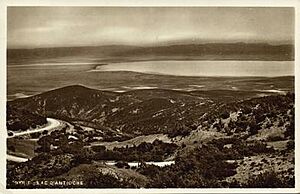Lake Amik facts for kids
Lake Amik, also known as the Lake of Antioch, was a large freshwater lake in Turkey. It was located in Hatay Province, near the ancient city of Antioch (now Antakya). This important lake was completely drained between the 1940s and 1970s.
Contents
The Story of Lake Amik: A Look Back
Lake Amik was found in the middle of the Amik Plain. This area is part of a large crack in the Earth's crust called the Dead Sea Transform. The lake used to cover about 300 to 350 square kilometers. It grew even larger during flood times. The lake was surrounded by big marshy areas.
Scientists have studied the lake's sediments. They believe Lake Amik grew to its final size about 3,000 years ago. This happened because of floods and dirt building up at its outlet to the Orontes River. The lake's growth forced many old settlements to move.
Life Around the Lake
The lake became a key source of fish and shellfish for the people living nearby. It was also important for the city of Antioch. An Arab geographer named Abu al-Fida wrote about the lake in the 14th century. He said it had sweet water and was 20 miles (32 km) long and 7 miles (11 km) wide.
Later, in the 18th century, a traveler named Richard Pococke visited the area. He noted that locals called it "Bahr-Agoule," which means "the White Lake." They called it this because of the color of its waters.
By the 20th century, about 50,000 people lived in 70 villages around Lake Amik. They raised animals and harvested reeds from the lake. Fishing was also very important, especially for eels. During summer, when the water went down, they grew crops and animal food on the exposed land. People also built special homes called Huğ using reeds from the lake.
Wildlife and Ecology of Lake Amik
Lake Amik was a very important home for many animals. It was on the migration path for many waterfowl and other birds. White storks and pelicans often stopped there. The lake was also known for a special group of African darters that lived only there.
Unique Species of the Lake
The lake was home to birds found nowhere else. This included a possible unique type of black francolin. There was also a distinct southern Turkish bearded reedling. A fish species called Hemigrammocapoeta caudomaculata was only known from Lake Amik. Another fish, the Jordan himri, was found in Turkey only in this lake.
When the lake was drained, these unique bird and fish species disappeared forever. This greatly harmed the local wildlife. Another similar habitat, Lake Hula in Israel, was also drained around the same time.
Draining the Lake
People started draining and reclaiming land around Lake Amik in 1940. The main reasons were to create more land for growing cotton and to get rid of malaria. Malaria was a disease spread by mosquitoes that lived in the lake's marshy areas.
The Drainage Project
A big drainage project began in 1966. It involved directing the lake's rivers, the Karasu and the Afrin, straight into the Orontes River. More work was finished by the early 1970s. By this time, the lake was completely drained. Its bed was turned into farmland.
Today, Hatay Airport has been built in the middle of where the lake used to be.
Problems After Draining
There have been many reports that draining Lake Amik caused serious environmental problems. The reclaimed farmland has become very salty. This has made the land less productive for farming. Even with the drainage, many areas still flood regularly. This means drainage canals need constant upkeep, which further lowers farm productivity.
Also, the underground water level has dropped a lot. It used to be about 20 meters deep, but now it can be as deep as 400 meters in some places. This drop in underground water has caused the ground to sink. This sinking has led to serious damage to buildings in the area.


